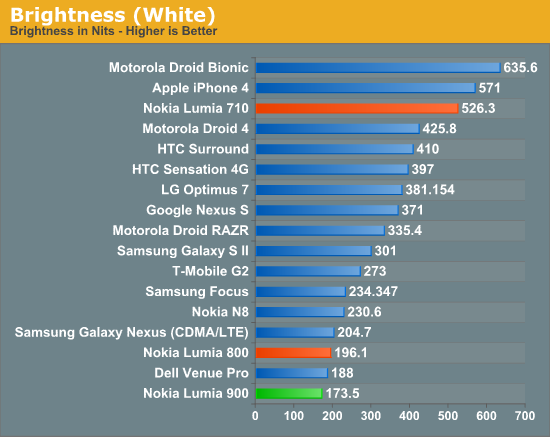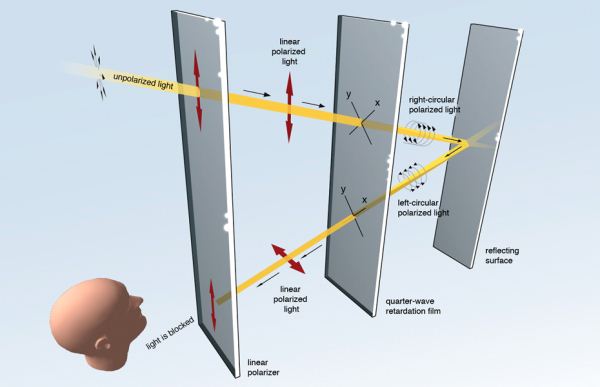Nokia Lumia 900 Review - Windows Phone with LTE
by Brian Klug on April 3, 2012 9:00 PM ESTDisplay Quality
Like the Lumia 800, the Lumia 900 uses an AMOLED display instead of an LCD. One of the chief differentiators between the two models however is the difference in subpixel rendering. Whereas the Lumia 800 used a 3.7“ PenTile RGBG SAMOLED panel, the Lumia 900 uses a 4.3” SAMOLED+ panel with an RGB subpixel stripe. Those names fit, that is, if we’re following Samsung’s naming scheme, and as an aside this is undoubtedly a Samsung panel.
The effective resolution of both displays are 800x480 WVGA, like all Windows Phones, however. Jumping up in display size pretty much necessitates that change to RGB, since PenTile really only works when subpixels are below human visual acuity. In addition, we’ve already seen 4.3" SAMOLED+ WVGA displays out of Samsung (see the Focus S).
I measured the Lumia 900 display using an i1D2 just like I’ve done with numerous other smartphones, though at this point the advanced color and gamut information will have to wait until I make some targets. Again, because AMOLED is emissive, black color pixels are literally off, so contrast graphs are omitted. The Lumia 900 doesn’t go super bright, like other AMOLEDs I’ve seen. In fact, it’s slightly dimmer than the Lumia 800’s maximum of 196 nits. Remember that going to a larger display, especially AMOLED due to its emissive nature, increases power demands as r^2 since we’re talking about areal size.
| Lumia 900 Display Metrics | |||
| Brightness Level | Black Brightness (nits) | White Brightness (nits) | White Point (K) |
| Low | 0 | 72.68 | 6635 |
| Medium | 0 | 140.06 | 6930 |
| High | 0 | 173.55 | 6812 |
Nokia was able to get the Lumia 900 display nice and close to 6500K, which is interesting considering how many other AMOLED displays I’ve seen which are up near 8000K or higher and noticeably blue all the time.

I glossed over ClearBlack on the previous Lumia reviews partly due to time constraints, partly due to not knowing the exact details of their optical path. That said, it was immediately obvious that the system used circular polarization’s behavior upon reflection to attenuate back reflections. However, since writing those reviews, Nokia has outlined their optical system in a conversations post, and the long and short of it is that the system consists of a linear polarizer and quarter-wave plate.
Incoming diffuse light gets vertically polarized by a surface polarizer, which becomes right hand circularly polarized when passing through the quarter wave plate. When circular polarized reflects off of a surface, it changes handedness - in this case from right to left handed circular. Upon passing through the quarter wave plate on its way out, this becomes horizontally polarized, which is then strongly attenuated by the surface polarizer with its fast axis aligned vertically on its way out, which acts like an analyzer. The end result is that outdoors the only reflection you’ll get is from the first surface, not the surface of the display itself, which does reduce resulting glare.
This change also permits the Lumia 900 to still look bright outside, and in turn allows Nokia to run the display at a lower brightness and save some amount of power. For a while I was waiting for some OEM to introduce a system using polarization to diminish back reflections, and Nokia has done it with ClearBlack.
Indoor viewing angles for the Lumia 900 are excellent as evidenced by the purple test pattern from WP Bench not changing color at extreme field angles. In addition, I subjectively can’t find any issues with the display - there are none of the other problems that affect the higher dot pitch AMOLEDs such as grain or mura. Outdoor viewing angles are likewise good for the Lumia 900 in part thanks to ClearBlack.

















128 Comments
View All Comments
nitrousoxide - Tuesday, April 3, 2012 - link
"1.4GHz APQ8060"..apparently it's not dual-core.Brian Klug - Wednesday, April 4, 2012 - link
Oops, fixed! Thanks!-Brian
mister2d - Tuesday, April 3, 2012 - link
@Brian KlugYou mentioned tethering in the article. Can you talk more about whether you need a separate tethering plan for the Lumia 900 or can you just enable it out of the box without a fuss.
I asking since I am considering a jump from the original unlimited plan from AT&T/iPhone.
Thanks
Brian Klug - Wednesday, April 4, 2012 - link
Correct, just like other first-party AT&T phones it has a provisioning check to make sure you're paying a monthly rate for tethering.Otherwise it's functionally the same as every other phone I've tested with tethering - 5 clients maximum, WPA2, etc.
-Brian
jjj - Tuesday, April 3, 2012 - link
You are way too kind with this phone.The OS lacks so many features,the SoC is almost 2 gens behind,the recycled design is expired and fat(fat by even last year's standards) and the Windows brand can't ever be made apealing anymore.
Nokia can make nice hardware and ,i guess,we all want it to see it survive but they should have done better.
Aenean144 - Wednesday, April 4, 2012 - link
Concur.The only modern component in the thing is LTE, and that is arguably 1 year late. The SoC is 2010 era. The display is 2011 era, and I think I'm being generous. The OS software is still running a year's worth of development late compared to competitors. Microsoft has to wake up!
Even the chassis design isn't something stunningly new. It's nicely evolved from the design language introduced in the Nokia N8 almost 2 years. So we've seen this type of design for awhile. Nokia's messaging for this phone has been all wrong. They should have never let the media overhype this product.
MS has another card they can play: an Intel x86 Windows 8 smartphone. It's coming. A stylus and x86 compatibility will be features. ;)
sprockkets - Wednesday, April 4, 2012 - link
"I have to say that I’m impressed with how much Nokia Drive has improved since its initial launch on Windows Phone 7 with the Lumia 800. As of this writing the version is 2.0.0.2148, and it feels much more polished and responsive now since last I used it, and includes a few new features. The current version still requires you to preload maps for the regions you want over WiFi (so be sure you do this before getting in the car), but you basically get the ability to pre-cache whatever maps you want instead of hoping you have network connectivity where you’re going like with Google Navigation."You can pre cache maps as well with Google - just activate it in the labs dept, then download the area you need.
Also, stock browser on the HTC Sensation with the ICS update gets around 2000ms for sunspider. 6127ms is so outdated :)
Brian Klug - Wednesday, April 4, 2012 - link
Oh I know about that, but the radius ends up being too small for it to be practical or efficient. Eg if you're trying to cache a long roadtrip whose distance exceeds the radius, you'll need to precache multiple regions as opposed to just downloading all the maps.Also I need to update my SGS2 results with the ICS ROM. Unfortunately I had to send back the Sensation a while ago :/
-Brian
sprockkets - Wednesday, April 4, 2012 - link
Then again my HTC Sensation has maps from them (HTC Locations) and I can pre cache entire regions. Somehow it can also sync it up with Google's Navigation as well.tipoo - Wednesday, April 4, 2012 - link
Is it enough for a map of one city at least?